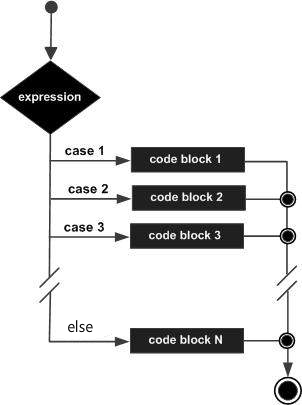Perl switch statement
A switch statement allows you to test when a variable is equal to more than one value. Each value is called a case, and the variable being tested checks each switch case.
Switch case execution is based on the Switch module, which is performed using Filter::Util::Call and Text::Balanced, both of which need to be installed.
Grammar
The syntax format looks like this:
use Switch;
switch(argument){
case 1 { print "数字 1" }
case "a" { print "字符串 a" }
case [1..10,42] { print "数字在列表中" }
case (\@array) { print "数字在数组中" }
case /\w+/ { print "正则匹配模式" }
case qr/\w+/ { print "正则匹配模式" }
case (\%hash) { print "哈希" }
case (\&sub) { print "子进程" }
else { print "不匹配之前的条件" }
}
Here are the rules for the switch statement:
- You can use any type of standard argument in the parentheses of a switch statement.
-
You can have any number of case statements in a switch. Each case is followed by a value to compare and a colon.
-
The calibration after the case statement is compared to the stum of the switch statement to determine whether it is equal.
-
When the variable being tested is equal to the constant in case, the statement followed by case is executed until a break statement is encountered.
-
The switch statement can have an optional else, which is executed at the end, and the statement executes in the event that all case mismatches.
-
When case is matched, the case statement block code is executed and the switch statement jumps out after execution.
-
When the case is matched, if we need to continue with the next case statement, we need to add the next statement.
Flow chart

Instance
#!/usr/bin/perl
use Switch;
$var = 10;
@array = (10, 20, 30);
%hash = ('key1' => 10, 'key2' => 20);
switch($var){
case 10 { print "数字 10\n" }
case "a" { print "字符串 a" }
case [1..10,42] { print "数字在列表中" }
case (\@array) { print "数字在数组中" }
case (\%hash) { print "在哈希中" }
else { print "没有匹配的条件" }
}
The above procedure is performed and the output is:
数字 10
Let's look at an example that uses next:
#!/usr/bin/perl
use Switch;
$var = 10;
@array = (10, 20, 30);
%hash = ('key1' => 10, 'key2' => 20);
switch($var){
case 10 { print "数字 10\n"; next; } # 匹配后继续执行
case "a" { print "string a" }
case [1..10,42] { print "数字在列表中" }
case (\@array) { print "数字在数组中" }
case (\%hash) { print "在哈希中" }
else { print "没有匹配的条件" }
}
The above procedure is performed and the output is:
数字 10 数字在列表中
 Perl conditional statement
Perl conditional statement